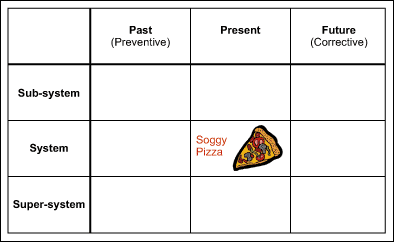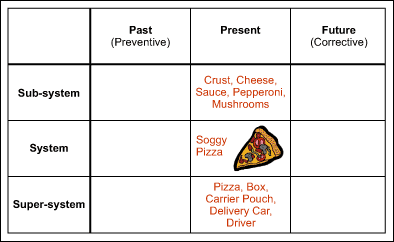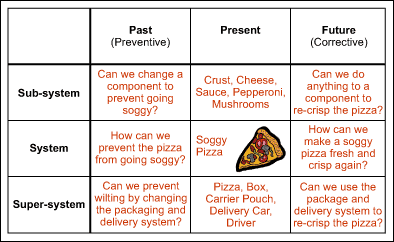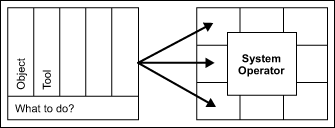By Ellen Domb, Joe A. Miller and Ralph G. Czerepinski
Beginner TRIZ Teaching Technique
The system operator (also called 9 windows or multi-window) is a visual technique that is used frequently in the initial stages of TRIZ, as part of problem definition. It is particularly helpful when the problem has been stated vaguely, and the people doing the work need to make the definition more specific before they can apply any of the problem solving methods of the Theory of Inventive Problem Solving (TRIZ).
Challenge to Beginners
The system operator shares a characteristic with many of the other TRIZ tools; it can be used by itself by people with very little knowledge of TRIZ and produce great benefits. Although integrating the TRIZ tools produces much greater benefits, experience with TRIZ beginners shows that they have two reasons that they need to get some benefit very quickly in order to be able to pursue the study of TRIZ:
- Companies are reluctant to invest in training, support and practice of a new methodology until they have seen benefits. This remains a central issue for the propagation of TRIZ.
- The TRIZ student's feeling of mastery of a tool encourages him to learn more of the system, and to practice the application of the tool that has given him that satisfying feeling. Eventually, this leads to doing the hard work of learning the whole system, but without the early successes, many people will not do the work or pursue the study.
This extremely simple case study guides the new TRIZ student through a simple form of the system operator – used for problem solving. The uses of the system operator for exploring patterns of evolution and technology forecasting are excluded, in the interest of getting the beginner to a useful solution to a specific problem, quickly.
How to Begin
The directions to the students are to construct a 3x3 matrix, with the rows labeled as the system, sub-system, super-system and the columns labeled past, present, future. Since time travel is not yet an available technology, the "past" column can also be labeled as "preventive," as a short form of, "If we could have done something in the past to prevent the problem from occurring, what would it have been?"
The graphic is visual and because of the global knowledge of the tic-tac-toe game it is an easy tool for beginners to set up. As with many matrix tools, documentation of the contents of each cell is necessary apart from the creation of the template. For example, Figure 1 shows step 1 of the case study of a soggy piece of pizza. Separate documentation is necessary to define the problem in detail – the pizza was baked at a pizza shop, delivered to a home, the delivery takes typically 25-35 minutes (with statistics if available), what fraction of customers complain about sogginess, are the people who are trying to solve the problem the home purchaser or the pizza shop or the suppliers to the pizza shop, etc. In a rigorous example, a separate set of system operators might be constructed for each of the possible problem solvers; in this example, opportunities for all of them are considered together.
Figure 1: Step One of the Simplified System Operator:
What Is the Problem at the System Level? |
|  |
|
|
In step 2 the sub-systems, or components, of the system are listed and the super-system is identified. Sometimes there are multiple possible super-systems. In this case, the pizza is part of the family dinner super-system, and it is also part of the pizza production and delivery super-system. In this informal, beginner use of the system operator, just listing these elements of the problem and the accompanying discussions if a team is working on the problem may suggest solutions to the problem or pathways to be investigated to generate solutions. For example, listing "mushrooms" as a component leads to a discussion of how mushrooms emit water when cooked. Maybe if the mushrooms were kept in a separate container, the pizza would be crisp? This is a path to investigate (and an example of inventive principles 2, take out and 3, local quality, too).
Figure 2: Step Two of the Simplified System Operator:
What Are the Sub-systems, Components and Super-systems? |
|  |
|
|
In step 3, the problem solvers explicitly consider the questions:
- "How could we prevent the problem, operating at this level?" for the preventive column and
- "How could we fix this problem, operating at this level?" for the corrective column.
Figure 3: Step Three of the Simplified System Operator:
Ask How to Remove the Problem For Each Box |
|  |
|
|
Examples are shown in Figure 3 for all three levels. For a TRIZ beginner, this would be a good step at which to pause and construct at least one question for each of the boxes. If the question prompts an answer, like "put the mushrooms in a separate container" for the subsystem/preventive box, great – the beginner now has something to do or has discovered an area for more research. If the question does not prompt an answer, the beginner has the input to the next stage of TRIZ – to get that question answered.
It is easy to expand the system operator in many directions. In the pizza example, the box collects moisture that evaporates from the pizza and condenses on the cold surface of the box. Considering separately what to do about the box, the moisture, the heat transfer, etc., could produce new thinking about crisp pizza. Figure 4 illustrates how "What do do?" can lead to solution expansion, by asking the question for each of the five elements of the complete system in each of the 9 windows of the system operator.
| Figure 4: Ask "What To Do?" Questions |
|  |
|
|
Conclusion
The system operator is a powerful tool when used as part of the integrated TRIZ methodology, but it is also a simple tool that beginners can use very quickly: 1) to get the results that they need to encourage them to continue their study of TRIZ and 2) that their organizations need to continue to support TRIZ work.
References
- Mann, Darrell, System Operator Tutorials, The TRIZ Journal, September, November and December 2001 and January 2002.
- Serediski, Avraam, System Operator and the Methodology of Prediction, The TRIZ Journal, January 2002.
- Miller, Joe and Domb, Ellen, Applying the Law of the Completeness of a Technological System to Formulate a Problem, The TRIZ Journal, January and December 2007.
- Jirman, Pavel and Bušov, Bohuslav, Development of the Technological System Tool as a Basis of TRIZ, Proceedings of ETRIA TRIZ Futures 2007, Frankfurt, Germany, November 2007.
About the Authors:
Ellen Domb is the founder and principal TRIZ consultant of the PQR Group. She is also the founding editor of The TRIZ Journal and a commentator for Real Innovation. Contact Ellen Domb at ellendomb (at) trizpqrgroup.com or visit http://www.trizpqrgroup.com.
Joe A. Miller is principal of Quality Process Consulting, an independent consulting firm. Contact Joe A. Miller at jam (at) prairietriz.com.
Ralph G. Czerepinski holds a B.S. in chemistry from the University of Wisconsin and a Ph.D. in chemistry from the University of Washington. He retired at the end of 2001 after more than 34 years with the Dow Chemical Company. His career spans a wide variety of polymer, coating, adhesive, composite and reprographic applications and corresponding fundamental studies. During his last years at Dow, he served as TRIZ coordinator for the entire company. Dr. Czerepinski holds 7 U.S. patents. He is principle with Cz innovation, a consulting firm, and is an associate of PQR, Inc., a TRIZ training and solution provider and a quality practices consulting firm. Contact Ralph G. Czerepinski at ralph (at) czere.com or visit http://www.czere.com.
Copyright © 2006-2011
– RealInnovation.com, CTQ Media. All Rights Reserved
Reproduction Without Permission Is Strictly Prohibited –
Request Permission
Publish an Article: Do you have a innovation
tip, learning or case study?
Share it
with the largest community of Innovation
professionals, and be recognized by your peers.
It's a
great way to promote your expertise and/or build your resume.
Read more about submitting an article.